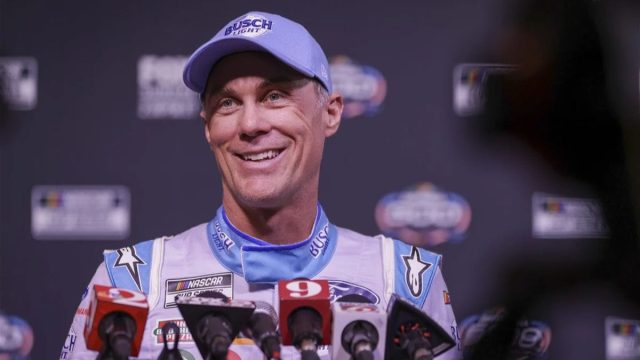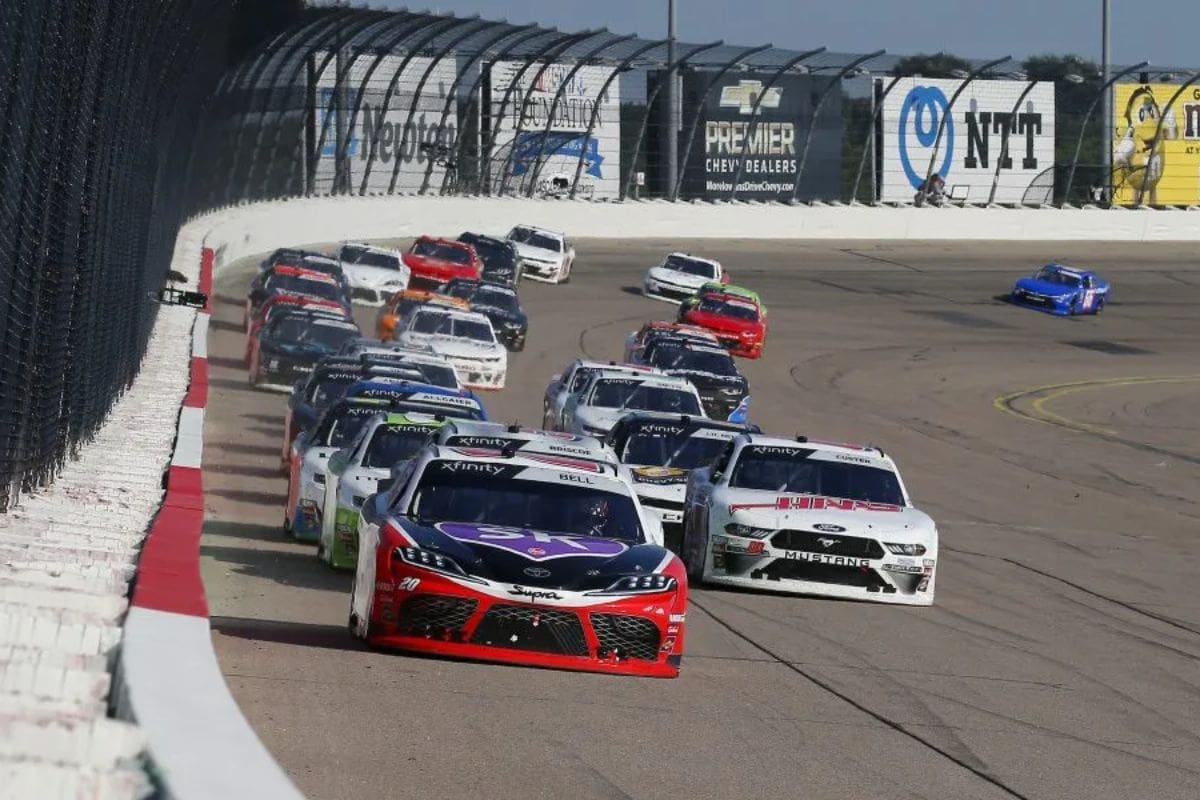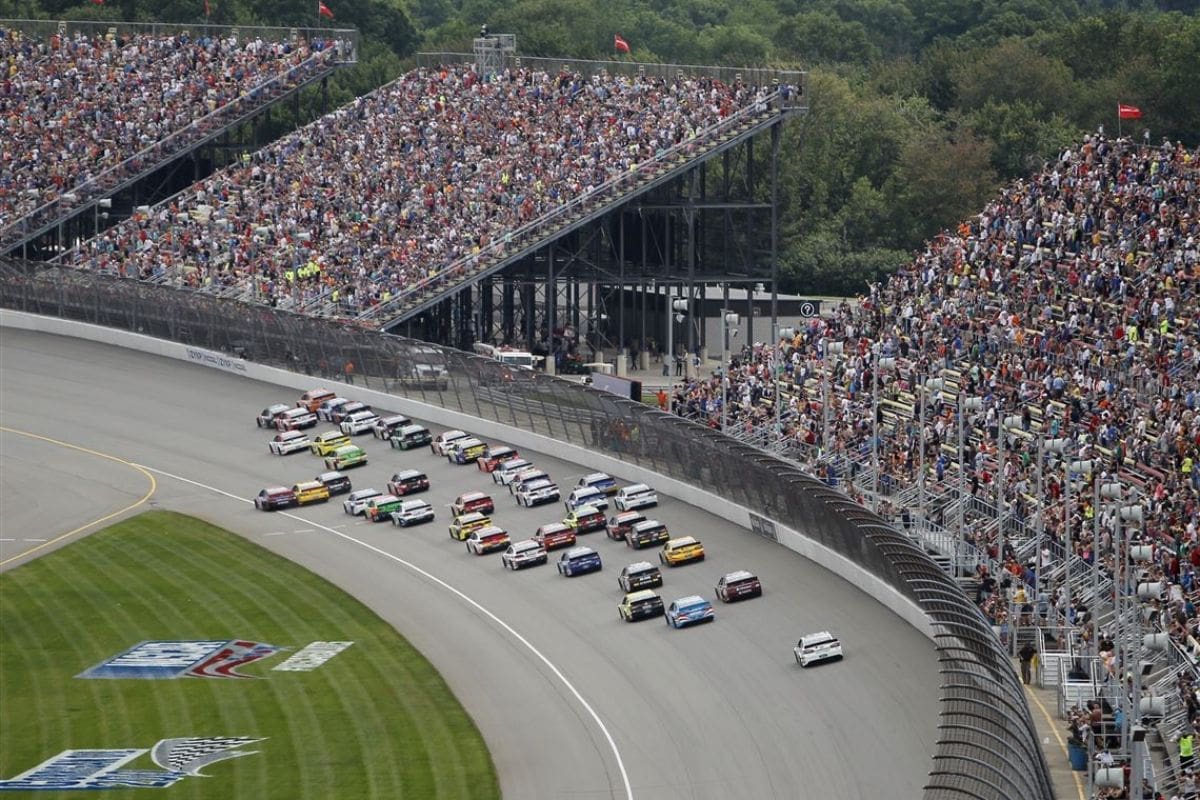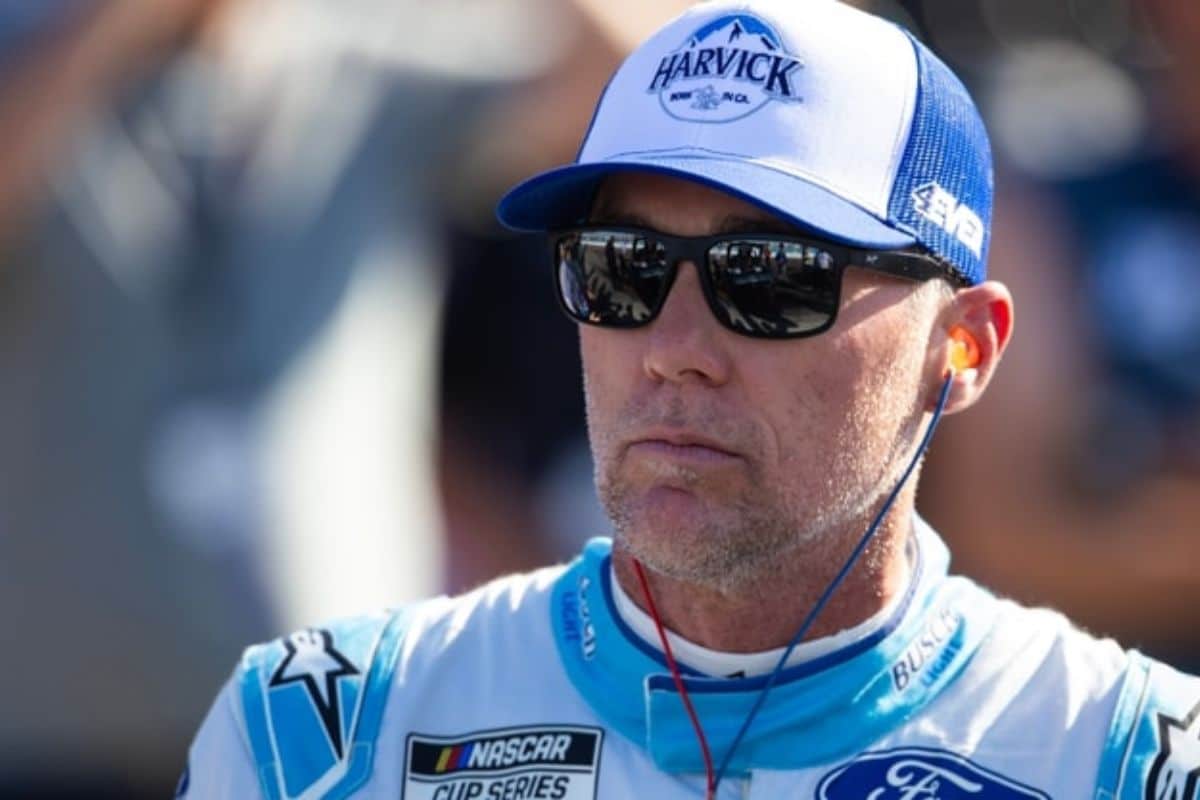NASCAR Makes Epic Blunder: NASCAR’s recent decision to repave only a portion of Iowa Speedway has ignited criticism and confusion among drivers, fans, and industry insiders. This half-measure approach, focusing solely on the inside grooves, has left many questioning the motives and planning behind such a move. Notable voices in the racing community, including Kevin Harvick, have openly expressed their frustration and skepticism. Meanwhile, social media reactions further underscore the widespread dissatisfaction. This article delves into the specifics of the repaving controversy, highlighting the critical viewpoints of Harvick, the insights from journalist Bob Pockrass, and the fervent responses from fans.
Frustration with Partial Repaving
Kevin Harvick discusses a controversial repaving decision at a racetrack. He expresses frustration and criticism about the decision to repave only part of the racetrack—from the middle of the track downwards—rather than repaving the entire track or corner. Harvick suggests that this partial repaving creates an uneven racing surface, limiting drivers’ ability to utilize the entire track effectively.
“What? The repave. The world decided to repave this racetrack. I don’t care how about it. You had to run one with the old asphalt.” – Harvick
From a driver’s perspective, this decision is baffling and downright frustrating. When a track is partially repaved, it introduces a variety of complications that wouldn’t exist with a full repave. The inconsistency in the asphalt can lead to unpredictable grip levels, making it difficult for drivers to find a rhythm and forcing them to constantly adapt their driving styles. This isn’t just a minor inconvenience; it’s a significant change that affects the entire race strategy and vehicle setup. Harvick points out, “If you’re gonna repave it, repave the whole corner because now you’ve got a half a racetrack.”
Harvick’s comments highlight a critical issue that often plagues racing decisions—lack of consultation with those directly impacted. Drivers, who spend hours testing and racing on these surfaces, should have a significant say in such decisions. Instead, it appears that this repave was decided upon with little to no input from the drivers, leading to widespread frustration. The decision to repave only half the track can be seen as a shortcut, an attempt to fix a problem without fully committing to a proper solution.
“I’m not sure who made that decision to repave that racetrack like that. I’m sure there were a scenario that says oh the asphalt was sliding or this or that big patches in there somewhere.” – Harvick
From the drivers’ standpoint, this move feels like a betrayal. The expectation was for a complete and thorough repaving that would enhance the racing experience, not diminish it. The partial repaving has now created an unpredictable environment, adding an unnecessary layer of difficulty to an already challenging sport. Harvick’s candid critique is a call to action for those in charge to rethink their approach to track maintenance and to include drivers in these crucial decisions. “At least got through one race with the way that the asphalt was.”
I applaud Harvick for saying this publicly. I wish they could be this blunt during the broadcast. pic.twitter.com/Mi7qs5VnRL
— Dylan (@dgoodin24) June 12, 2024
Questioning the Motivations
Harvick questions whether the repaving was done for the benefit of NASCAR or if it was driven by the needs of IndyCar, hinting at a potential misalignment in priorities. He implies that the decision might not have been made with NASCAR’s best interests at heart, suggesting that it could be a case of catering to another racing series at the expense of NASCAR drivers and fans.
“Is it repaved for us or was it repaved because IndyCar needed the repave? It doesn’t. I don’t know.” – Harvick
In a move that seems more driven by convenience than by genuine concern for the sport, NASCAR has once again shown that it’s willing to take the easy way out. The decision to repave only a portion of the racetrack reeks of short-sightedness and poor planning. If this was done to appease IndyCar, it demonstrates a disturbing trend where NASCAR seems to be pandering to other interests rather than focusing on the needs and safety of its own drivers. Harvick’s exasperation is palpable: “You know what I mean because we haven’t been going there. Yes. So I know that IndyCar had been there.”
“We’ll do whatever we feel like doing,” without considering the broader implications. The drivers are left to deal with the fallout, navigating a track that is now a patchwork of old and new surfaces. This half-measure approach not only undermines the integrity of the sport but also raises questions about the decision-making processes within NASCAR. Are they truly committed to providing the best possible racing experience, or are they just ticking boxes and making decisions on a whim?
“This might be one of the biggest F-ups in the in the whole year. Did you think for the car to have to say it but I have to say it because it is one of the big biggest mess ups that we could possibly have this year.” – Harvick
Drivers like Harvick have every right to be skeptical and concerned. When decisions are made that clearly don’t prioritize the primary participants of the sport, it signals a deeper problem within the organization. NASCAR must recognize the need for transparency and inclusivity in its decision-making processes. Ignoring the voices of those who live and breathe the sport daily is not only disrespectful but also detrimental to the overall quality and safety of the races.
“And when I saw those pictures from the tire test of the racetrack repaved, every driver in that field was looking forward to being able to run anywhere on the racetrack and now you have half the racetrack.” – Harvick
Impact on Racing Experience
Harvick emphasizes that the decision to repave in this manner is one of the biggest mistakes of the year in terms of track management, and he speculates that the issue might not have been well-publicized or communicated to the drivers beforehand. This lack of transparency and foresight can significantly impact the quality and fairness of the racing experience, creating unnecessary challenges and risks for the drivers.
“I’m not sure who made that decision to repave that racetrack like that.” – Harvick
The drivers, who had high hopes for a more versatile and engaging racing experience, are now left grappling with a subpar track. This decision undermines their confidence in the governing body and casts a shadow over the sport’s integrity. When drivers can’t trust that the track will be consistent and safe, it affects their performance and their willingness to push the limits. This isn’t just about a bumpy ride; it’s about the fundamental principles of fairness and safety in racing.
“This is definitely one of the biggest mistakes that they could have made to a racetrack.” – Harvick
NASCAR’s approach to this repaving issue appears haphazard and careless. The lack of communication with the drivers not only shows a disregard for their expertise but also highlights a significant gap in NASCAR’s operational strategies. Instead of being proactive and inclusive, the organization seems to be making decisions in isolation, leading to widespread dissatisfaction and concern. This kind of decision-making is not only detrimental to the sport but also erodes the trust and respect that drivers and fans have for NASCAR.
“I don’t think anyone knew that. I don’t think I ever saw it. It wasn’t advertised for a reason I would say.” – Harvick
Ultimately, the partial repaving is more than just a technical issue—it’s a symbol of broader problems within NASCAR. The organization needs to reassess its priorities and ensure that its decisions are made with the best interests of all stakeholders in mind. Until then, drivers like Harvick will continue to speak out, highlighting the flaws and calling for more thoughtful and comprehensive approaches to track management and other critical aspects of the sport.
“It is definitely one of the biggest mistakes that they could have made to a racetrack.” – Harvick
NASCAR must take this criticism seriously and work towards regaining the trust of its drivers and fans. A successful and respected racing organization listens to its participants and makes decisions that enhance the sport, not hinder it. By involving drivers in the decision-making process and ensuring transparency, NASCAR can avoid such blunders in the future and maintain the integrity and excitement of the sport.
Pockrass Comments on Repave
Bob Pockrass’s tweet about the repaving of the Iowa Raceway brings to light a deeply controversial decision made by NASCAR. While NASCAR had full control over how the track was repaved, the execution of this project leaves much to be desired. According to Pockrass, the decision to repave only the inside groove(s) was influenced by factors such as weather, available asphalt, and the time required for the paving and settling processes. However, this explanation does little to quell the frustration and disappointment felt by drivers, fans, and critics alike.
One of the most glaring issues with NASCAR’s approach is the apparent lack of foresight and planning. Repaving only the inside groove(s) instead of the entire track or at least the full corner demonstrates a short-sightedness that is hard to ignore. NASCAR’s decision seems to have been driven more by convenience and immediate constraints rather than a long-term vision for the track’s usability and the overall racing experience. Pockrass’s mention of weather and available asphalt suggests that logistical challenges took precedence over what was best for the sport and its participants.
Pockrass’s tweet implicitly criticizes NASCAR’s handling of the situation, hinting at a broader problem of mismanagement and poor decision-making. By opting for a partial repave, NASCAR has effectively created a track with inconsistent grip levels and unpredictable racing conditions. This not only undermines the integrity of the races held at Iowa Raceway but also puts drivers at an increased risk. The decision appears to have been made in haste, with little regard for the feedback or needs of the drivers who are directly affected by such changes.
The frustration is palpable among the racing community, and Pockrass’s tweet encapsulates this sentiment. He highlights that the timing of the repave was a key factor, yet this does not excuse the subpar outcome. NASCAR’s inability to coordinate a complete and thorough repaving job suggests a deeper issue within the organization’s operational strategies. It raises the question of whether NASCAR is prioritizing expedience over quality and safety, a notion that is both troubling and infuriating to those who expect the highest standards from one of the premier racing organizations in the world.
I applaud Harvick for saying this publicly. I wish they could be this blunt during the broadcast. pic.twitter.com/Mi7qs5VnRL
— Dylan (@dgoodin24) June 12, 2024
Ultimately, Pockrass’s tweet serves as a pointed critique of NASCAR’s decision-making process. It underscores the need for NASCAR to rethink its approach to track maintenance and management. The decision to repave only the inside groove(s) is not just a logistical failure but a significant misstep that could have lasting repercussions for the sport. NASCAR must learn from this controversy and strive to make more informed, comprehensive decisions that prioritize the long-term health and integrity of the tracks, the safety of the drivers, and the quality of the racing experience.
Fan Reactions to the Iowa Raceway Repave Decision
Bob Pockrass’s tweet about the Iowa Raceway repave sparked a wave of reactions from fans, many of whom expressed significant displeasure and confusion about the decision. The overwhelming sentiment among the fans is one of frustration and skepticism, as they question both the necessity and execution of the repave. Their responses reveal a deep-seated concern about NASCAR’s decision-making processes and priorities.
“Was anybody asking for a repave? I didn’t recall any issues with Indycar last year with it but people are saying Indycar was the reason it was repaved?” – fans’ reaction
This comment highlights a key point of contention: the perceived lack of demand or necessity for the repave. Fans seem to believe that if there were no significant issues with the track during IndyCar events, then the decision to repave, especially in such a limited and partial manner, is questionable at best.
“@iowaspeedway didn’t need a repave. @goodyear either can’t or doesn’t have enough time to make a usable tire compound that can take the punishment at high wear tracks for the new gen car. That trend has been getting easier to see as they go to new tracks or tracks that are aging.” – fans’ reaction
This response suggests that the underlying issue may not be with the track itself but with the tire manufacturer’s inability to adapt to the demands of high-wear tracks. The fan implies that Goodyear’s limitations are being masked by unnecessary and poorly planned track repaves.
Idiots
— Anderson (@_1017__) June 11, 2024
“This sounds like a bunch of nonsense you’d say when you were caught trying to pave corners,” underscores the skepticism surrounding the official explanation for the repave. Fans are not buying the logistical excuses offered by NASCAR, and there is a palpable sense that the organization is trying to cover up a poorly thought-out decision. This mistrust is echoed in another blunt reaction: “Idiots.” Such strong language indicates that fans are not only unhappy but also feel disrespected and deceived by the decision-makers.
“I dunno. I find it hard to believe they just had no resources or time to have done at least 2 lanes all the way through the corners. Like come on.” – fans’ reaction
This skepticism points to a broader issue of perceived incompetence and lack of foresight within NASCAR’s management. The fan finds it implausible that NASCAR could not muster the resources or time to execute a more comprehensive repave, suggesting that the decision was more about cutting corners than addressing real needs.
News in Brief: NASCAR Makes Epic Blunder
The backlash against NASCAR’s partial repave of Iowa Speedway underscores a significant disconnect between the decision-makers and the broader racing community. As highlighted by Kevin Harvick and echoed by fans, the move raises serious questions about NASCAR’s priorities and operational strategies. The frustration and skepticism voiced by many reflect a broader call for more thoughtful and inclusive decision-making processes.
NASCAR must take these critiques seriously, reassessing its approach to track maintenance and ensuring that future decisions prioritize the needs and safety of drivers while maintaining the integrity of the sport. The controversy serves as a stark reminder of the importance of transparency and engagement in fostering trust and respect within the racing community.
ALSO READ: NASCAR Playoff Hopes Fade for Busch and Logano After Sonoma



